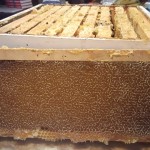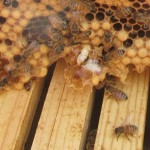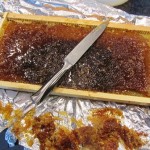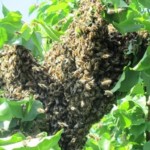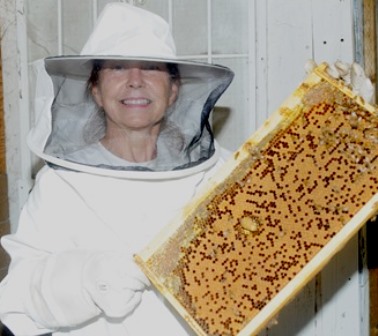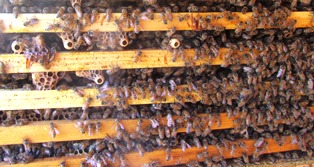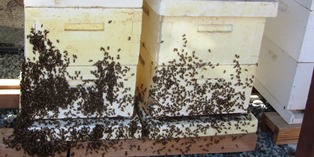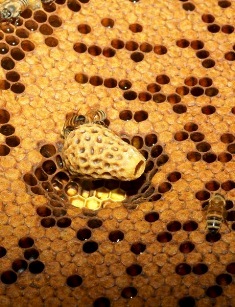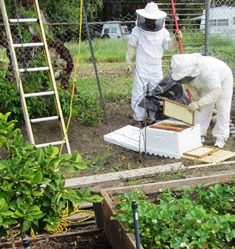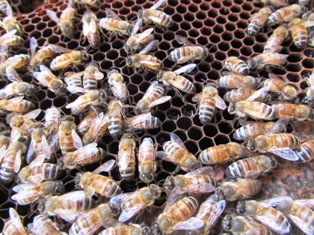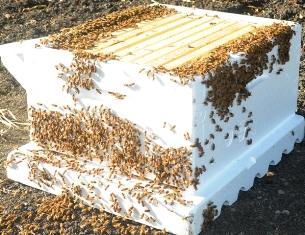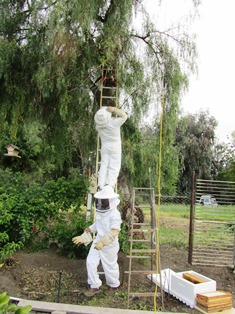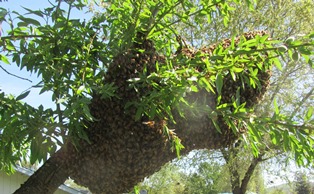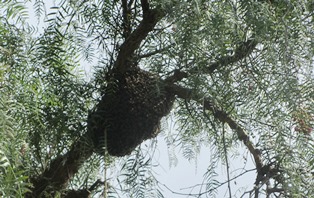Harvesting Honey–Helping Hands Always Welcome
When it comes to opening the hives of honey bees here on our farmette, I’m grateful for the helping hands of my hubby and my neighbor. Carlos, my hubby and helpmate for life, is my go-to guy for all our farm projects. And our neighbor Peter not only has answers to my questions about bees, but also he can open a hive, remove frames of honey, inspect and medicate, and seal the unit lickety-split.
With the smoker at the ready and lit, we opened our hives September 23, 2018. The hives were robust, but the bees appeared stressed. I had added supers to each hive in late July but should have kept a closer eye on the burgeoning bee population. They had become overcrowded and hungry.
For harvesting, we first removed the heavy metal lid of the hive box, replacing it with a fume board. A fume board is a lid lined with fabric that is sprayed with a product that encourages the bees to vacate the supers (some bees immediately leave the box; others go into the brood chambers). The fume board works within seven to ten minutes. We then pulled out the frames of honey, gently brushed off any remaining bees, and took the honey-heavy frames to the kitchen.
For an old hand at beekeeping like my neighbor, the process went quick. Not so for me. This past year, I injured both my shoulders with tears in the rotator cuff tendons. With limitation to some of my range of motion, I’ve felt pretty handicapped. Still, I helped by carrying a single frame of honey at a time from the hive box to the kitchen.
While the hives were open, we removed old medicated strips previously hung in the boxes to thwart mites.
- Small sheets for trapping hive beetles are placed across the frames in the top super before closing the lid
We also replaced the Bee-Gone sheets to trap hive beetles. It’s important to properly handle such items and to keep the apiary clean. We put in medication for mite control–a white gelatinous substance spread on a paper similiar to an index card. Finally, we placed a single patty of bee food on the frames to provide for the bees’ nutritional needs.
The bees immediately coalesced on the patty; no longer stressed, they seemed gentle and calm. Checking the bottom frames, we found a lot of brood (eggs, larvae and pupae of bees). To help this new generation of honey bees along, we inserted an unopened frame of honey that I’d kept wrapped in foil and frozen (freezing kills any insects that could infect the hive or bees). Honey, of course, is the perfect food for them.
We will reopen the hives in two weeks and re-check the status of the bees. A that time, we’ll treat with an antibiotic for winter and possibly add a super if necessary.
I haven’t yet processed the honey we harvested but the frames are on my kitchen counter. They are in a hive box wrapped in aluminum foil. At the ready are also several food-grade buckets that I’ve carefully washed, dried, and covered with lids. The honey spinning machine has been cleaned. Before I begin working with the honey in the frames, I always scrub my kitchen, washing the countertops twice–first with soap and water and then with diluted bleach and hot water.
When everything is clean, I will begin to work on each frame. I first scrape away any bee “glue” from the outside edges of the frame. With a hot knife, I slice all around the interior edges before opening the sealed wax cells (sliding the hot knife just under the wax and lifting). Both sides of the frame are dealt with in this manner. After the wax cells are uncapped, the frame will be placed into the spinning machine. It uses centrifugal force to spin off the honey. The sweet stuff then drains through the strainer material taped around the bucket mouth. The bucket is positioned under the machine spigot.
My reward for this labor of love is having an abundance of sweet, amber honey when desired to bake a honey cake or other culinary creation, to enjoy a relaxing cup of tea, or to fill jars for holiday gift-giving. Beekeeping draws people together and, take it from me, a helping hand is always appreciated.
_______________________________________________________________________________
If you enjoy reading about keeping bees and chickens, growing heirloom vegetables and fruits, or living the farmette (small farm) life, check out my offering of books that tie into themes of living well and close to the Earth.
Grab one or more of my cozy mysteries (no gratuitous sex, profanity, or violence) and discover delicious farm recipes, gardening advice, and tips for caring for bees and chickens.
Or pick up one of my wellness, spirituality, or manifesting books. They make great holiday gifts for yourself and others.
All my books are available in traditional bookstores everywhere and also online at Amazon.com, Barnes & Noble (barnesandnoble.com), Kobo Books, Walmart, and other retailers.
For more information, click on the following URLs:
A HIVE OF HOMICIDES
MURDER OF A QUEEN BEE
A BEELINE TO MURDER

More than 150 rituals for sound mind, strong body, and meaningful connections to the people around you
https://www.amazon.com/dp/B0719HHVRJ/ref=dp-kindle-redirect?_encoding=UTF8&btkr=1
Swarm in July–Does It Really Mean, “Ain’t Worth a Fly?”
Yesterday, after I’d fed and watered the chickens, I grabbed a two-gallon bucket and a ladder to pick some apricots for canning. But my morning didn’t go as planned when I spotted a cloud of bees swarming in the very fruit tree I was preparing to climb into. Nothing like a honeybee swarm to make you switch tasks in a hurry.
There’s a centuries-old saying among beekeepers: A swarm of bees in May is worth a load of hay . . . a swarm of bees in June is worth a silver spoon . . . a swarm of bees in July ain’t worth a fly. My beekeeper neighbor says simply, “A swarm in July . . . bye bye.” The rhyme echoed in my brain. Even early July? Should I try to save them? I donned my beekeeper suit and gathered together the items I would need for the rescue.
Ironically, in late winter I had hung a swarm catcher in the tree next to the swarm. A swarm catcher makes it easy to hive the bees since they are all inside the bucket-shaped unit with a small hole on one side and a large covered opening on the other. They go inside and you dump the bees into the hive box. I’ve had three swarms this year and not one of them went into the swarm catcher despite me putting attractant (a type of scented oil) in the vial inside the unit. Go figure!
Yesterday’s swarm wasn’t as big as the two I captured in May and June. I’m not even sure if I could save this one, but trying was better than losing them. I decided to help the small population along but putting into their hive some frames of comb and honey.
A swarm at this time of year (approaching the end of swarming season) will require extra food if the bees are to make it through autumn when they kick out the drones and then winter when their food and nectar sources become scarce.
I draw hope from the fact that August in the Bay Area brings blooms to certain species of eucalyptus and also star thistle. My bees also have access to lots of lavender. I have planted several types of it around my farmette.
The sunflowers in my garden are blooming now and will (thanks to consecutive planting) over the next several weeks. And I’ve got two raised beds designated as bee gardens full of blooming flowers and herbs like borage that attract bees, butterflies, and other pollinators.
It remains to be seen if this July swarm will have any worth at all. I think they’re going to need a lot of help. That means keeping my eyes on them as I take care of my chickens and keep the summer canning going.
_____________________________________________________________________________
If you enjoy reading about the workings of an urban farmette and also appreciate a good, clean mystery, check out my Henny Penny Farmette series of cozy mysteries–A BEELINE TO MURDER, THE MURDER OF A QUEEN BEE, and A HIVE OF HOMICIDES. I also write wellness and spirituality books–SACRED TRAVELS (soon to be updated to include color images), RITUALS FOR LIFE, and MY POCKET MEDITATIONS.
All my books are available at Barnes & Noble, Amazon, and other traditional and online bookstores everywhere.

More than 150 rituals for sound mind, strong body, and meaningful connections to the people around you
Harvesting Honey–A Labor of Love
Sitting in the middle of my kitchen is a three-story hive box with thirty frames of honey that needs to be extracted, filtered, and poured into jars.
My apiary is small–just two hives. Taking the honey is quite a labor-intensive activity. But it brings its own kind of joy. As pollinator populations decrease, keeping bees is a small thing I can do for all of us . . . for our planet.
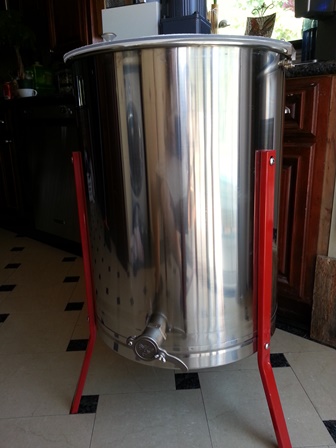
This electric honey extractor holds four frames; honey is spun out through centrifugal force and drains through the spigot
The stainless steel honey extractor, washed and scrubbed, has been pushed over by the oven to make a little space in my already-small kitchen.
Today, I washed the countertops, my stove, and even the sink with hot soapy water and bleach. Then after a thorough wipe-down, I stretched sheets of aluminum foil over the countertop. The extraction process started with four frames.
It’s a simple process. I set the four frames of honey on the foil-covered counter. Using a hot knife, I open the capped cells on both sides of the frames and put them in the honey extractor. Beneath the machine’s spigot, I’ve already positioned a five-gallon bucket with strainer attached. I start the machine on a slow speed and open the spigot.
Each of the five gallon and two-gallon buckets were previously washed and covered with strainers. These are held in place with heavy duty duct tape wrapped around the mouths. Switching out a full bucket for an empty one is easy when the buckets are prepped for use before the extraction starts.
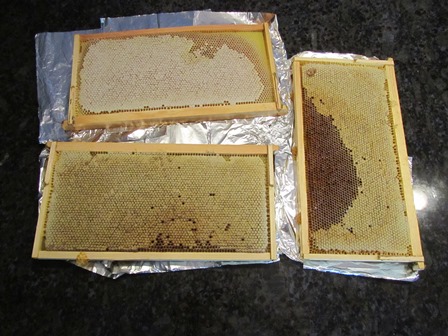
Springtime honey appears golden in the frames whereas autumn honey is often darker (depending on what’s flowering, but often star thistle and eucalyptus, in my area)
I expect a yield of about thirty-five gallons this time. I lost one hive . . . more on that later, but, in all, it looks to be a good honey harvest for our family and friends.
As soon as I extract all the honey, I’ll start bottling it and affixing labels. It’s a process that will take several days to complete.
Tasting, smelling, and seeing all this golden, delicious honey that the bees created warms my heart. When we take care of them, they take care of us. And we always leave plenty of honey in the hives for the bees to eat throughout the winter.
* * *
If you enjoy reading about farmette topics (including gardening, beekeeping, and delicious recipes), check out my Henny Penny Farmette cozy mysteries series from Kensington Publishing.
These novels are chocked full of recipes, farming tips, and sayings as well as a charming cozy mystery.
See, http://tinyurl.com/hxy3s8q
This debut novel launched the Henny Penny Farmette series of mysteries and sold out its first press run. It’s now available in mass market paperback and other formats.
See, http://tinyurl.com/h4kou4g
JUST RELEASED! This, the second cozy mystery in the Henny Penny Farmette series, is garnering great reviews from readers and industry publications.
My books are available through online retailers such as Amazon, Barnes & Noble, Kobo Books, and Walmart as well as from traditional bookstores everywhere.
Birds that Eat Bees
Lately, I’ve noticed a scrub jay visiting my apiary. The bird most often lands on the bubbling water fountain near the front of the hives, but it visits other fountains in the yard as well. A favorite spot is the pink birdbath near the Pyracantha bush and stand of bamboo.
The bird eats its fill of bees corpses on the gravel path in front of the hives. Occasionally, I’ve seen it snatch a bee out of the air–something I don’t like. After washing down its meal with water, off it goes.
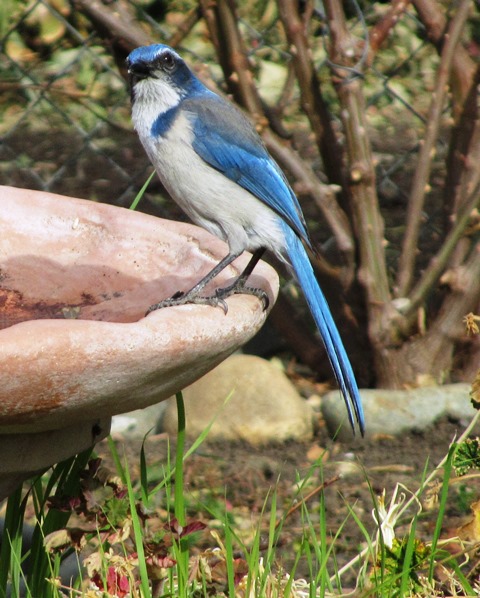
Western scrub jays are omnivores and eat nuts, seeds, berries, small rodents, reptiles, other birds’ eggs, and insects.
While bees aren’t the primary dietary food of scrub jays, the birds will eat bees that are dead or alive.
Purple Martins, the largest type of swallow in the United States, eats bees in flight, too, provided the insects zoom high enough to enter the Purple Martin’s flight zone.
Other birds that eat bees include flycatchers, tufted titmice, swifts, and shrikes (because of their feeding habits, some shrikes are known as “butcher birds” because they impale prey on thorns). European beekeepers must deal with Bradfield’s swift and the Green Bee-eater; both eat bees that are flying about to forage or mate.
The majority of bee-eating birds belong to a relatively small group of twenty-four species that feed mainly on honeybees but also devour bumblebees, dragonflies, wasps, ants, butterflies, hornets, beetles, and moths as part of their diets.
But back to the scrub jay–these birds serve a custodial function for my apiary. With dead bees attracting hornets and yellow jackets, the scrub jay is doing me a favor by cleaning up around the hive entrances. This is especially true in the autumn, when the worker bees preparing their hive for winter, push out the drones (male honeybees) to die.
* * *
If you enjoy reading about farmette topics (including gardening, beekeeping, and delicious recipes), check out my cozy mysteries A BEELINE TO MURDER and also THE MURDER OF A QUEEN BEE in the Henny Penny Farmette series (from Kensington Publishing).
These novels are available through online retailers such as Amazon, Barnes & Noble, Kobo Books, and Walmart as well as from traditional bookstores everywhere.
See, http://tinyurl.com/hxy3s8q
Now available in mass market paperback, this debut novel launched the Henny Penny Farmette series of mysteries and sold out its first press run.
See, http://tinyurl.com/h4kou4g
The second cozy mystery in the Henny Penny Farmette series, available Sept. 27, 2016, is now available on Net Galley (netgalley.com) for professionals and readers who write reviews.
The Bees Won’t Wait
With so many flowers in bloom now, it’s time to add supers to the hives.
I can hear the buzzing from my patio, about twenty to thirty feet from the hives. My bees want to make honey, raise babies, and swarm . . . I know it.
My neighbor and I are opening hives tomorrow, but I worked out in the apiary today getting extensions (known as supers) ready. These have shorter frames and the bees use them to build wax cells and store honey.
I’ve got two active hives and extras. And I have several supers, complete with the shorter frames ready to go.
There are about ten frames I can use in a super that are being housed in the outdoor freezer. It’s where I put frames to kill anything that could live over on them that I don’t want in a hive, like a wax moth. The cold kills.
I also cleaned the bee glue off another hive box with larger frames in the event the bees decide to swarm sooner rather than later. The bees won’t wait. They’ll need a new house ready when they swarm or they’ll fly away and find one elsewhere.
Swarming Season Has Arrived!
What’s not to love about spring? It’s only the middle of April and already we’ve seen several honeybee swarms. Swarming is how the bees reproduce their colonies and most often occurs during the warm days of early spring.
My neighbor, whom I’ve often called a world-class beekeeper (his father kept honeybees in Lebanon and taught him well) permitted me to keep his bee swarm that alighted in my apricot tree. He also generously donated a super (hive box) with some frames that already had wax, honey, and capped brood–all from his own apiary.
The newly housed honeybee workers delight in foraging on the various types of lavender (Spanish, English, and French perfume) that I’ve planted around the farmette. The colony will build up the wax and make honey while the nursemaid bees will care for the brood.
My husband, the architect-turned-farmer/beekeeper, has constructed a unique bee house for the hives. It will keep the bee boxes dry during winter rains and out of reach of marauding animals (skunks and raccoons). Resting on a platform that Carlos built on top of a newly installed brick floor, the hives are not within easy reach of the ever present ant population.
Alas, the bees weren’t about to wait until Carlos finished building their house. The swarm happened when the bees were ready to take flight (some 60 percent of the workers with their old queen) flew into our apricot tree.
If you see a swarm, call your local beekeeping association (or any store that carries local honey) for the name of a beekeeper. Avoid the temptation of spraying water or anything else on the swarm. Permit the beekeeper to safely remove the swarm.
For a beekeeper, rescuing a swarm is a truly exhilarating experience. Often a swarm consists of thousands to tens of thousands of honeybees. Beekeepers routinely rescue swarms from where bees have temporarily clustered while the bee scouts seek a permanent home. The beekeeper can shake them into a prepared hive box, leaving the box at the hive cluster site until all the bees are inside. At that point, the beekeeper takes the new hive to his apiary.
The beleaguered honeybees (whose populations have been decimated by the Varroa mite, weakened immune systems, and Colony Collapse Disorder) need help to survive and increase their populations. We need them, too! Without their pollination of fruit, nut, and other crops, our own food sources diminish.
Saving the honeybees is a good practice whenever possible because doing so ensures abundance and diversity in the plants we eat. Whenever I see a cluster of bees in a tree I feel joyful and celebratory. Is it any wonder that swarming season is my favorite time of the year?
An Extra Blanket for the Bees
With Thanksgiving only a couple of weeks away, weather is turning downright frosty at night. I asked my beekeeper neighbor if it was time for us to throw some blankets over the hives to help the beleagured honeybees stay warm. We did this last year along with feeding the bees with a good result of thriving hives in the spring.
In the wintertime, the honeybees cluster toward the middle of the hive, their muscles responsible for flight now shivering (albeit in a different way than when taking flight), to generate heat. The colder it gets, the tighter the cluster and harder the bees have to work to stay warm. If the the core temperature of the hive drops too low, the colony will die. See http://indianapublicmedia.org/amomentofscience/honeybees-winter/
During winter months, proper ventilation to maintain a dry hive is a must. Since bees eat and metabolize honey to generate heat, carbon dioxide and water are produced. The carbon dioxide, heavier than air, descends and exits the bottom of the hive while the water vapor rises to the cold inner roof and drips back down as condensate on the poor bees. Freezing and starvation can cause bee die-offs in the winter.
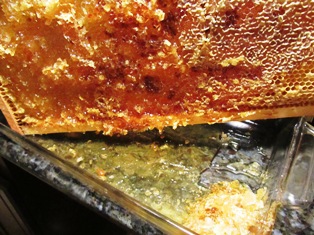
Bees eat and metabolize honey from stores within the hive during winter when outside food sources are scarce
We drape each hive with a blanket over the top and around the back and sides, but not in front where the openings are located. Bees need to be able to enter and exit. As soon as the temperatures warm, my neighbor and I pull back the blankets during the day.
Some might suggest that putting out an extra blanket for the bees is interfering with nature’s processes and survival of the fittest, but on the other hand, the colony has remained strong and healthy over this last year.
Human use of pesticides has wreaked untold harm on the population of these important pollinators. Isn’t it about time, we considered the plight of the bees and did something to help them survive, like planting excellent food sources for every season and giving them medicine when they need it an an extra blanket for warmth? See, http://www.mariasfarmcountrykitchen.com/help-honey-bees-survive-winter/
A Swarm in July Isn’t Worth a Fly
There’s an old proverb about bees that goes: A swarm in May is worth a load of hay, a swarm in June is worth a silver spoon, but a swarm in July isn’t worth a fly. You might wonder why.
Well, I asked my beekeeper neighbor that question this morning as we suited up to feed the bees and take some frames of honey. The hives were thriving, bees were active, and the honey production copious. He harvested some, but also left some for the babies that the queen had produced.
There are spring flowers in May and new flowers in June, but by July many of the flowers that the bees love to forage on have flowered and gone to seed. If the queen lays lots of babies, where will the worker bees get enough pollen and nectar to support the entire hive, feed the queen, and supply the babies?
During fall in Northern California, the bees can forage on the eucalyptus blossoms, but then, they must survive through winter. I see bees on my December roses, but there aren’t a lot of flowers blooming in December that have high pollen and nectar loved by the bees.
Swarming in May and June is a sight to behold. Swarming is way the bees of deal with hive/nest overcrowding. It is how they increase their populations. See, http://entomology.unl.edu/beekpg/beeswarm.shtml.
A savvy beekeeper is ready to capture swarms as soon as the weather warms up in late spring. The bees won’t wait, although it is possible for a seasoned beekeeper to anticipate a swarm and take action to avert it. But it doesn’t always work.
An apiarist must manage his or her colony of hives and anticipate the needs and activities of the bees for the coming season–at this time of year, that means during fall and winter. Without a lot of food growing to support a new hive of bees from a captured swarm, a swarm in July isn’t worth a fly.
Honeybees Have Distinct Personalities
I don’t wear perfume in the garden least the bees think I’m a flower and light on me. But if they do, I let them walk around and explore. I don’t swat at them. Why would I? Honeybees are generally among the most docile of all bees.
Honeybees also have different personality types, according to research published in 2012 in the magazine Science and based on a study by Gene Robinson, University of Illinois entomology professor and director of the Institute for Genomic Biology. See, http://news.illinois.edu/news/12/0308bees_GeneRobinson.html
Scavenging and reconnaissance work carries more risk and challenge, whether you are human or honeybee. An adventuresome personality is usually best suited for that kind of work. Robinson and his researchers observed that the honeybees that do the nest and food scouting express distinct patterns of gene activity in molecular pathways that have been associated with thrill-seeking.
Whereas the adventurous scouts choose the thrill of taking off, the more intrepid and timid bees tend to stick closer to home, doing the tasks of building the hive, cleaning it, caring for the babies, and making honey. Robinson’s research debunks the ages-old idea that the colony’s workers are interchangeable.
America’s first honeybees arrived in from Europe by ship to the American colonies in the 17th century. It took approximately 200 years for the honeybees to get to the West Coast from that early introduction. Some went feral. See, http://www.orsba.org/htdocs/download/Honey%20Bees%20Across%20America.html
The most aggressive honeybee personality is the Africanized bee (aka, killer bees). These bees attack (often in droves) if they perceive a threat to their nest or queen. See, http://www.independent.ie/world-news/americas/couple-attacked-by-swarm-of-30000-bees-who-kill-their-two-horses-29456104.html
The Africanized bees have spread from Brazil, where honeybees from Europe (highly valued for pollinating crops and producing honey) were interbred with bees from Africa. These bees were inadvertently released in the 1950’s in Brazil and began to migrate north. They are now in Texas, New Mexico, Nevada, Arizona, and California. See, http://bees.ucr.edu/ahb-facts.html
All this information about work and personality types as it relates to honeybees makes me wonder: If we humans suited our work to our personality types, would we work as contentedly as do the bees in the garden and those in the hive?
Déjà Vu
I heard the whine even before I looked up and saw the honeybees coalescing into a swarm. I was on my knees at the back fence of the farmette helping my husband Carlos remove weeds from under the pepper tree. I dashed into the kitchen to retrieve a stainless steel pan and, using the gardening trowel still in my hand, began banging on the pan’s bottom.
My beekeeper neighbor swears that the banging noise disorients the bees so they will take refuge in a nearby tree instead of flying miles away. This was the second swarm in as many weeks on our farmette.
The swarm from my neighbor’s hive alighted in the tall pepper tree at our back fence line. Just a week or so ago, a swarm landed in our almond tree. Dressed in his beekeeper’s suit and gloves, my neighbor arrived carrying a black garbage bag fastened to an empty bee box secured with tape. He and Carlos figured they would affixed the box to a long pole–our tree limb trimmer.
Carlos volunteered to climb the tall sectional ladder and began to suit up. He would be the rope puller who would shake the limb. The rope was already there thanks to a swarm last year in the same spot.
I wondered if shaking the bees off that high limb would work. They would have to drop precisely into the box that my neighbor would be positioning under the the writhing swarm. What if the bees fell, missed the box, and flew right back up?
Well, it did work. Most of the bees landed in the garbage bag. The bag was duly shaken over the prepared hive. There, the bees stayed. Our neighbor went home to his own gardening chores, and Carlos and I resumed our weeding, albeit in a different part of the property since a few stressed-out bees were still buzzing around that tree.
 Facebook
Facebook Goodreads
Goodreads LinkedIn
LinkedIn Meera Lester
Meera Lester Twitter
Twitter





